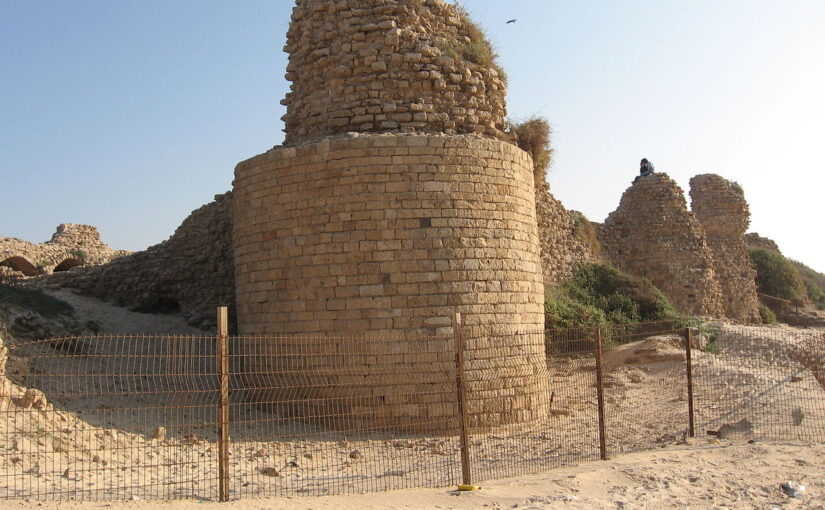The southern coast of Israel is a place where the Mediterranean constantly shapes sand and stone, creating long stretches of sun-drenched beaches and gentle dunes. Just south of the lively city of Ashdod lies a stretch of coast touched by centuries of history. Here, the waves whisper secrets of the past, and on certain mornings, the golden light dances over the ancient ruins of Chastel Béroard. The castle’s remains stand at the city’s sandy edge, not far from the sights and sounds of modern life. Yet, a short walk across the beach brings you face-to-face with silent centuries, where the vibrant blue of the sea meets the weathered gray of medieval stones.
Historical Background: From Fatimids to Crusaders
Long before Ashdod bloomed into one of Israel’s busiest ports, its coast was guarded by Chastel Béroard, also known by its Latin name, Castellum Beroart. Although the origins of this fortress reach back to the 10th century, when it was likely built by Fatimid Muslims from Egypt, the Crusaders would leave their most lasting mark. Strategically placed to watch over the sea, Chastel Béroard was meant to protect the vital road north from Ibelin to Ashkelon.
When Baldwin I, King of Jerusalem, arrived in the early 1100s, the castle served as both guesthouse and garrison. Only 15 kilometers separated it from the powerful Fatimid fortress of Ashkelon, a constant source of tension and intrigue in the region. Unlike larger Crusader castles, Chastel Béroard never became a centerpiece of grand strategy. Instead, it was a keystone in the defense of key coastal routes. After the fall of Ashkelon to the Crusaders in 1153, Chastel Béroard played an even more significant role as a watchful guardian along the well-traveled road and as a symbol of the shifting power across the coastline.
Through turbulent times, Chastel Béroard was attacked, renovated, and repurposed. The Crusaders improved its defenses, giving it a robust tower and stone fortifications to withstand raiders, pirates, and rival knights. While never as grand as other fortresses, its story is woven tightly into the patchwork of rulers and regional aspirations.
Key Figures and Strategic Role
Baldwin I is perhaps the most famous historical figure recalled by Chastel Béroard’s story. When he paused at the castle in 1106, it marked not only a royal stop but also a signal of the fortress’s importance. Over the years, the knights who held Chastel Béroard changed with the tides of Jerusalem’s power. Sometimes a holding of the lords of Ramla, sometimes a resting place for soldiers assigned to keep an eye on Ashkelon, the castle became a quiet player in the ongoing chess game along the southern Levantine coast.
Although the castle never hosted legendary sieges or royal courts, its position was always meaningful. Serving as a staging post, message relay, and supply depot, it stitched together the chain of Crusader communication between larger cities. Even after the Crusaders’ grip on the region loosened, and new empires pressed in, Chastel Béroard retained its identity as a post where east met west and travelers paused on their journey.
Cultural and Military Legacy
Chastel Béroard holds a different kind of legacy from the grander Crusader fortresses farther north. Its quiet presence is a reminder of the everyday pragmatism of medieval warfare, where not every fortification was built for showdowns or sieges. The castle served the rhythms of patrol and trade, its garrison looking out to sea or inward along the road, ever watchful for trouble or commerce.
In this way, Chastel Béroard reflects a broader pattern of military and cultural life along the Crusader coast. The Crusaders did not just build in stone; they wove a network of forts, outposts, and towers designed for endurance. Even as powers shifted and armies marched, the smaller castles like Chastel Béroard were the linchpins that held territories together, however briefly.
Why Visit Chastel Béroard?
Today, Chastel Béroard invites visitors with a sense of discovery. Its ruins are less imposing than those found in Acre or Belvoir, but they offer their own blend of charm and reflection. The location always surprises travelers, sitting quietly on the southern edge of Ashdod, embraced by dunes and caressed by the sea. There are no entrance queues or busy ticket offices. Most often, the breeze and the sound of the surf are your companions.
Exploring Chastel Béroard is a walk through layers of history. The battered stones and foundations evoke a time when every inch of coast was fiercely contested. It is a perfect place for a morning of solitude, for sketching, photography, or simply letting your imagination sweep back through centuries of trade, faith, and rivalry. Looking west, the sea stretches without end, while the eastern horizon buzzes with the vibrant life of modern Ashdod.
Visiting is also a chance to meditate on legacy. Unlike grand castles left behind as monuments, Chastel Béroard’s understated ruins are a quiet testament. They are proof that the guardians of history are often unsung. Yet, without these small castles, the story of the Crusader coast, with its daring raids and far-reaching ambitions, would be incomplete.
In Ashdod’s morning light, Chastel Béroard remains. It is a silent sentinel where land and sea meet, reminding each guest that history’s most lasting mark may come not from greatness, but from quiet vigilance and the unbroken watch of humble stones.
Image by ShmulikO.
If our work has inspired you, helped you grow, or simply brought a little warmth to your day, consider supporting Thalysia.com with a small donation. Your contribution helps us continue exploring ancient landscapes, documenting local traditions, and celebrating the art of living well.
